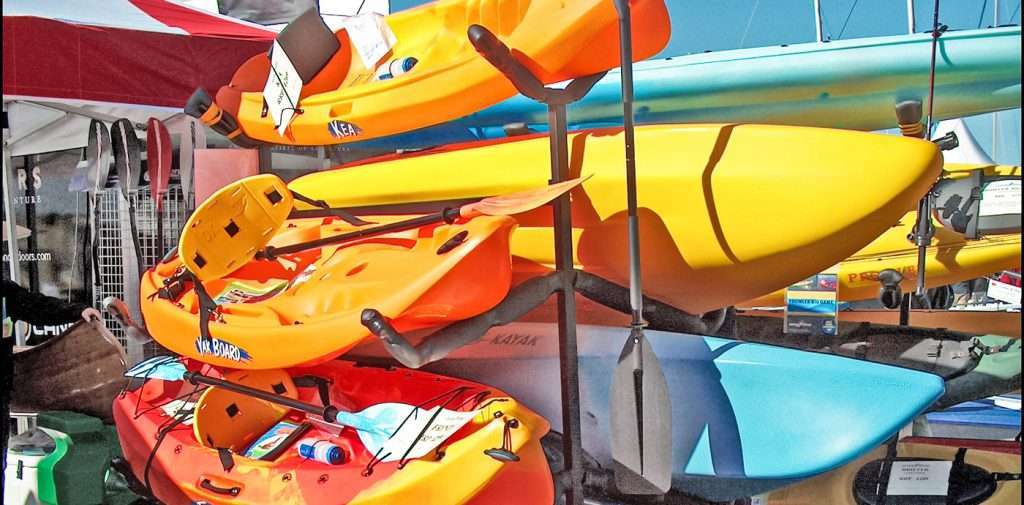A rudder is an important component to any kayak. While often associated with turning, the rudder is actually used most often for keeping the kayak moving straight. Making your own rudder is a good idea, because a kayak’s waterline determines the size of rudder you will need. Making your own rudder allows you to customize it specifically for your kayak, and ensures you’ve got a quality product.
Things You’ll Need:
- Rubber outline plan
- Sharpie marker
- 1/4-inch Plexiglas
- 1/8-inch Plexiglas
- Saw
- Belt sander, metal file, or jitterbug sander
- Knife
- Clamp
- Epoxy glue
- 1/8 inch Bolt
- 120-grit sandpaper
Step 1
Find and print an outline of a rudder schematic. Make sure the rudder plan is appropriate for the size of your kayak. The rudder should project 6 to 8 inches into the water, so keep this in mind when choosing the rudder plan. If the rudder piece is too big, you can always sand it down to make it smaller.
Step 2
Use a Sharpie to trace the outline sheet onto a sheet of Plexiglas. The following pieces of the rudder should be traced onto ¼-inch-thick Plexiglass: the rudder, the rope guide and the spindle housing. The rudder spool and the spacer for spindle housing/rudder rest should be traced onto 1/8-inch Plexiglass. Cut out the shapes using an appropriate saw.
Step 3
Prepare the rudder by sanding the edges to just below where the waterline will be. Also sand the backside of the pieces, just barely above the curve. Do not sand any part of the backside much further than just above the curve yet. Use a belt sander, metal file or a jitterbug sander to accomplish this. On the cutting edge of the rudder, use a knife to sharpen.
Step 4
Take the out edge of the spindle spool and sand it in a circular shape. Do not go overboard with sanding, because the spindle spool should be at least 3/8 inch larger than the inner spool of the rudder. Place the outer spool on the rudder, and mark on the rudder where the outer spool will go. Sand both sides of the outer spool just a little, about 1/32 of an inch. Place the outer spool on the rudder again, and mark the lines again.
It is time to glue, so set all the pieces up to attach the outer to spindles to the rudder. Spread a 5-minute epoxy glue inside the marked line on the rudder, and put the outer spindles on either side. Run a bolt through the spindles to hold them in place. Use a clamp, and leave the pieces to dry.
Step 5
Next, prepare the spindle housing by bolting and clamping the two pieces together. Sand them until they are identically sized. Prepare the spacers for the spindle housing and rudder rest by sanding them to the same size. Return to your outer spindle, as the glue should be dry by now. Sand any rough edges. Assemble all pieces, and gently sand with 120-grit sandpaper.
Step 6
Use a Sharpie to mark on the spindle housing where the spacer will go. Then glue these pieces together. Set the glue, clamp the pieces, and allow to dry. Use a bolt to attach one side of the rudder and spindle housing. Move them until they are square with each other, and mark a line to show where they are square. This line is where the rudder will be when its positioned down.
Take your robe guide and rudder spacer, and place the rudder spacer on the bottom, backside of the line you marked on the spindle housing. Glue the pieces down and clamp. Let them sit until they dry.
Step 7
Use 120-grit sandpaper to sand the pieces a little bit. Then take the other spindle housing and glue it to the other side, ensuring the rudder is in place and the bottom is flush. Before gluing, make sure the space in between is the same as on the other side.
Allow everything to dry, then once again examine the now-completed rudder for rough spots. Sand any of these and you are done.

